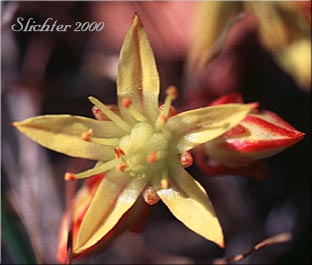 The
photo at right shows Sedum lanceolatum from 9400' on the Steens Mt......August
3, 1995.
The
photo at right shows Sedum lanceolatum from 9400' on the Steens Mt......August
3, 1995.
Lance-leaved stonecrop is a succulent, perennial herb, with smooth herbage and erect stems from 5-20 cm high, tufted from slender rhizomes. Frequently, many sterile shoots or basal rosettes of leaves are present. The leaves alternate on the stems and are found in dense clusters on the basal rosettes. Individual leaves are fleshy, about .5-20 mm long, linear or linear-lanceolate in shape, and ovate or round in cross-section. The tips of the leaves are blunt, unlike its close relative, Sedum stenopetalum, which may be found growing close by. The leaves may be greenish, reddish, or purplish in color, and may be covered with a white, waxy powder.
The inflorescence is a dense, flat-topped cyme. The flowers are about 1 cm across with 5 narrowly lance-shaped petals. The spreading petals are yellow, and may be tinged or striped with red. They range from 6-7m m in length, and are longer than the stamens. The sepals are triangular-lanceolate, and range from 2-3.5 mm long.
Stonecrop leaves are said to be edible, and I've seen reports that they have been used as food, but some species may cause headaches, diarrhea, or vomiting. It is probably best to leave them alone.
Stonecrops are easily propagated by leaf- or stem-cuttings. Place a stem in well-drained soil during the moist season, and it should begin to form roots quickly.
Lance-leaved stonecrop may be found on dry, open, exposed places which are gravelly or rocky. Such sites include ridges, slopes and rocky outcrops from sea level to alpine areas.
Lance-leaved stonecrop may be found from southern Alaska and the Yukon south to California and east to Alberta, South Dakota, Nebraska, Colorado, and New Mexico.
In the Columbia River Gorge, lance-leaved stonecrop is occasionally found in the Columbia Hills.
Basal cluster of leaves of lance-leaved stonecrop as seen in the Columbia Hills at the eastern end of the Columbia River Gorge.........May 10, 2009.